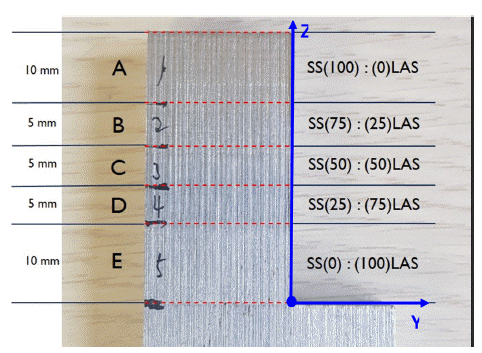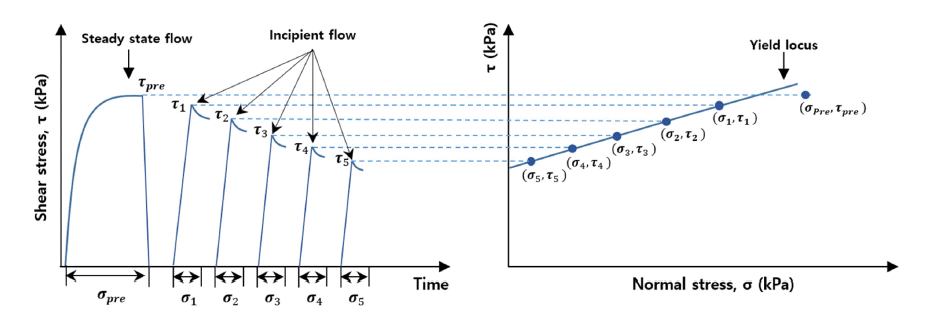- [Korean]
- Evaluation of Microstructures and Mechanical Properties in Functionally Graded Materials (STS 316L and Low Alloy Steel) Produced by DED Processes
-
G. Shin, W. Choo, J. H. Yoon, S. Y. Yang, J. H. Kim
-
J Powder Mater. 2022;29(4):309-313. Published online August 1, 2022
-
DOI: https://doi.org/10.4150/KPMI.2022.29.4.309
-
-
 Abstract Abstract
 PDF PDF
In this study, additive manufacturing of a functionally graded material (FGM) as an alternative to joining dissimilar metals is investigated using directed energy deposition (DED). FGM consists of five different layers, which are mixtures of austenitic stainless steel (type 316 L) and low-alloy steel (LAS, ferritic steel) at ratios of 100:0 (A layer), 75:25 (B layer), 50:50 (C layer), 25:75 (D layer), and 0:100 (E layer), respectively, in each deposition layer. The FGM samples are successfully fabricated without cracks or delamination using the DED method, and specimens are characterized using optical and scanning electron microscopy to monitor their microstructures. In layers C and D of the sample, the tensile strength is determined to be very high owing to the formation of ferrite and martensite structures. However, the elongation is high in layers A and B, which contain a large fraction of austenite.
- [Korean]
- Effect of Particle Sphericity on the Rheological Properties of Ti-6Al-4V Powders for Laser Powder Bed Fusion Process
-
T. Y. Kim, M. H. Kang, J. H. Kim, J.K. Hong, J.H. Yu, J.I. Lee
-
J Powder Mater. 2022;29(2):99-109. Published online April 1, 2022
-
DOI: https://doi.org/10.4150/KPMI.2022.29.2.99
-
-
774
View
-
22
Download
-
3
Citations
-
 Abstract Abstract
 PDF PDF
Powder flowability is critical in additive manufacturing processes, especially for laser powder bed fusion. Many powder features, such as powder size distribution, particle shape, surface roughness, and chemical composition, simultaneously affect the flow properties of a powder; however, the individual effect of each factor on powder flowability has not been comprehensively evaluated. In this study, the impact of particle shape (sphericity) on the rheological properties of Ti-6Al-4V powder is quantified using an FT4 powder rheometer. Dynamic image analysis is conducted on plasma-atomized (PA) and gas-atomized (GA) powders to evaluate their particle sphericity. PA and GA powders exhibit negligible differences in compressibility and permeability tests, but GA powder shows more cohesive behavior, especially in a dynamic state, because lower particle sphericity facilitates interaction between particles during the powder flow. These results provide guidelines for the manufacturing of advanced metal powders with excellent powder flowability for laser powder bed fusion. -
Citations
Citations to this article as recorded by  - Enhanced Microstructure and Wear Resistance of Ti–6Al–4V Alloy with Vanadium Carbide Coating via Directed Energy Deposition
Ui Jun Ko, Ju Hyeong Jung, Jung Hyun Kang, Kyunsuk Choi, Jeoung Han Kim
Materials.2024; 17(3): 733. CrossRef - Microstructural Evolution and Mechanical Properties of Ti-6Al-4V Alloy through Selective Laser Melting: Comprehensive Study on the Effect of Hot Isostatic Pressing (HIP)
Gargi Roy, Raj Narayan Hajra, Woo Hyeok Kim, Jongwon Lee, Sangwoo Kim, Jeoung Han Kim
journal of Korean Powder Metallurgy Institute.2024; 31(1): 1. CrossRef - Cryogenic Tensile Behavior of Ferrous Medium-entropy Alloy Additively Manufactured by Laser Powder Bed Fusion
Seungyeon Lee, Kyung Tae Kim, Ji-Hun Yu, Hyoung Seop Kim, Jae Wung Bae, Jeong Min Park
journal of Korean Powder Metallurgy Institute.2024; 31(1): 8. CrossRef
|



